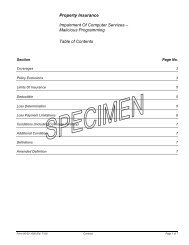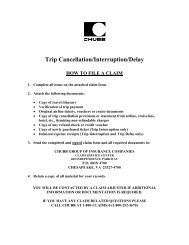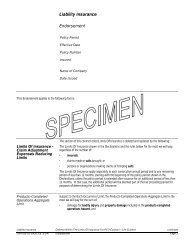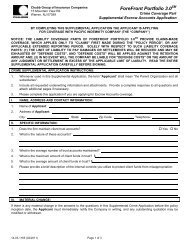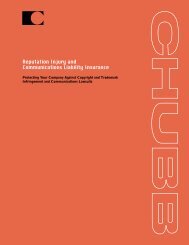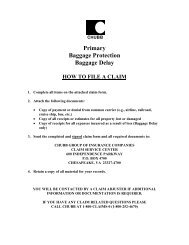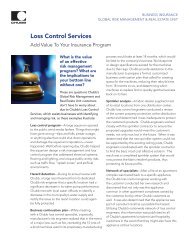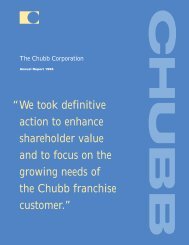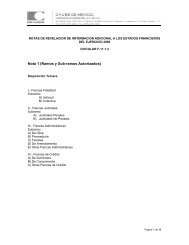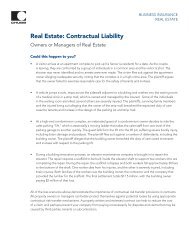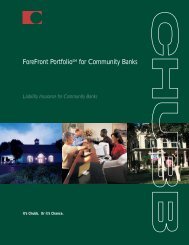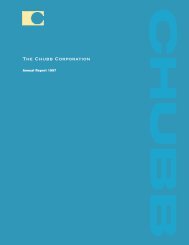Annual Report 2005 - Chubb Group of Insurance Companies
Annual Report 2005 - Chubb Group of Insurance Companies
Annual Report 2005 - Chubb Group of Insurance Companies
You also want an ePaper? Increase the reach of your titles
YUMPU automatically turns print PDFs into web optimized ePapers that Google loves.
District <strong>of</strong> New York. We are cooperating, and intend to continue to cooperate, fully with these<br />
investigations.<br />
We cannot predict at this time the outcome <strong>of</strong> these investigations or any impact on our business<br />
or results <strong>of</strong> operations.<br />
Catastrophe Risk Management<br />
Our property and casualty subsidiaries have exposure to losses caused by natural perils such as<br />
hurricanes and other windstorms, earthquakes, winter storms and brush Ñres and from man-made<br />
catastrophic events such as terrorism. The frequency and severity <strong>of</strong> catastrophes are unpredictable.<br />
Natural Catastrophes<br />
The extent <strong>of</strong> losses from a natural catastrophe is a function <strong>of</strong> both the total amount <strong>of</strong> insured<br />
exposure in an area aÅected by the event and the severity <strong>of</strong> the event. We regularly assess our<br />
concentration <strong>of</strong> risk exposures in catastrophe exposed areas globally and have strategies and<br />
underwriting standards to manage this exposure through individual risk selection, subject to regulatory<br />
constraints, and through the purchase <strong>of</strong> catastrophe reinsurance. We have invested in modeling<br />
technologies and a concentration management tool that allow us to monitor and control our<br />
accumulations <strong>of</strong> potential losses in catastrophe exposed areas in the United States, such as California<br />
and the gulf and east coasts, as well as in such areas in other countries. Actual results may diÅer<br />
materially from those suggested by the model. We also continue to actively explore and analyze<br />
credible scientiÑc evidence, including the impact <strong>of</strong> global climate change, that may aÅect our ability<br />
to manage exposure under the insurance policies we issue.<br />
Despite these eÅorts, the occurrence <strong>of</strong> one or more severe natural catastrophic events in heavily<br />
populated areas could have a material adverse eÅect on the Corporation's results <strong>of</strong> operations,<br />
Ñnancial condition or liquidity.<br />
Terrorism Risk and Legislation<br />
The September 11, 2001 attack changed the way the property and casualty insurance industry<br />
views catastrophic risk. That tragic event demonstrated that numerous classes <strong>of</strong> business we write are<br />
subject to terrorism-related catastrophic risks in addition to the catastrophic risks related to natural<br />
occurrences. This has required us to change how we identify and evaluate risk accumulations. We have<br />
licensed a terrorism model that provides estimates <strong>of</strong> loss events. We also have a concentration<br />
management tool that enables us to identify locations and geographic areas that are exposed to risk<br />
accumulations. The information provided by the model and the tracking tool has resulted in our nonrenewing<br />
some accounts and has restricted us from writing others. Actual results may diÅer materially<br />
from those suggested by the model.<br />
The Terrorism Risk <strong>Insurance</strong> Act <strong>of</strong> 2002 (TRIA) established a temporary program under which<br />
the federal government will share the risk <strong>of</strong> loss from certain acts <strong>of</strong> international terrorism with the<br />
insurance industry. The program, which was applicable to most lines <strong>of</strong> commercial business, was<br />
scheduled to terminate on December 31, <strong>2005</strong>. In December <strong>2005</strong>, the federal government extended<br />
TRIA through December 31, 2007. Under the terms <strong>of</strong> the amended law, certain lines <strong>of</strong> business<br />
previously subject to the provisions <strong>of</strong> TRIA, including commercial automobile, surety and pr<strong>of</strong>essional<br />
liability insurance, other than directors and oÇcers liability, are excluded from the program. As<br />
a precondition to recovery under TRIA, insurance companies with direct commercial insurance<br />
exposure in the United States for TRIA lines <strong>of</strong> business are required to make insurance for covered<br />
acts <strong>of</strong> terrorism available under their policies. Each insurer has a separate deductible that it must meet<br />
in the event <strong>of</strong> an act <strong>of</strong> terrorism before federal assistance becomes available. The deductible is based<br />
on a percentage <strong>of</strong> direct U.S. earned premiums for the covered lines <strong>of</strong> business in the previous<br />
calendar year. For 2006, that deductible is 17.5% <strong>of</strong> direct premiums earned in <strong>2005</strong> for these lines <strong>of</strong><br />
business. For losses above the deductible, the federal government will pay for 90% <strong>of</strong> covered losses,<br />
while the insurer retains 10%. In 2007, the deductible will increase to 20% <strong>of</strong> direct premiums earned in<br />
2006 and the insurer share for losses above the deductible will increase to 15%. There is a combined<br />
36



